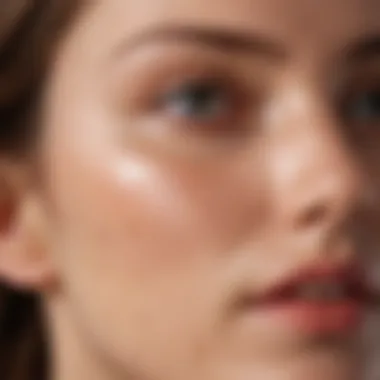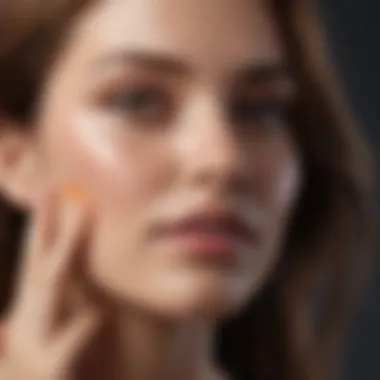The Ultimate Guide to Mineral Sunscreen Sprays for Your Face


Intro
Protecting your skin from the sun is a vital part of any skincare routine. Mineral sunscreen sprays, in particular, have gained attention for their effectiveness and ease of application. Unlike traditional sunscreens, which may leave a greasy residue, mineral spray options offer a lightweight solution that can be reapplied throughout the day for continued protection. They often contain physical blockers like zinc oxide and titanium dioxide, which shield the skin against harmful UVA and UVB rays.
This article will explore the essential features of mineral sunscreen sprays. We will look at their formulation and the specific benefits they provide. Furthermore, skin type compatibility will be discussed to help readers identify the right product for their individual needs. Through a comparative analysis of leading mineral sunscreen products, you can find detailed insights that clarify what options exist on the market.
Expert recommendations and usage guidelines will also be included, enriching your understanding of how best to incorporate these products into your daily skincare regimen. Ultimately, the aim is to equip readers with the knowledge necessary to make informed choices regarding facial sun care.
Understanding Mineral Sunscreens
Mineral sunscreens hold a unique position in sun protection strategies. They provide a physical barrier against harmful ultraviolet radiation. Understanding mineral sunscreens is crucial for selecting the right product. The benefits of these sunscreens often align with various skin types, making them a versatile choice for many. Their formulation and application can significantly impact skin health. Thus, exploring their definition and mechanisms helps users make informed decisions.
Definition and Composition
Mineral sunscreens primarily consist of active mineral ingredients such as zinc oxide and titanium dioxide. These compounds are finely milled to create a product that sits on the skin's surface. Their primary role is to reflect and scatter UV rays, preventing skin from absorbing them. Unlike chemical sunscreens, which absorb UV radiation, mineral options act as a barrier. This distinction is significant for those looking to minimize skin irritation, especially for sensitive skin types.
Moreover, mineral sunscreens usually do not undergo complex chemical reactions after application, making them suitable for various skin conditions like rosacea or eczema. Ingredients are often selected for their minimal risk of irritation or allergic reactions, making mineral formulas decidedly appealing to those seeking gentle yet effective options.
Mechanism of Action
The mechanism of action for mineral sunscreens involves physical blocking. When applied to the skin, zinc oxide and titanium dioxide form a protective layer. This layer reflects and diffuses both UVA and UVB rays. As a result, the skin remains shielded from sun damage. Unlike chemical alternatives, this protection is immediate, meaning users do not have to wait for the product to absorb into the skin before exposure.
"Mineral sunscreens provide instant protection without the need for chemical absorption, making them particularly suitable for sensitive skin."
Additionally, these sunscreens have the advantage of stability under sunlight. Unlike many chemical filters that degrade over time, mineral ingredients maintain their effectiveness during sun exposure. This stability contributes to their long-lasting protective qualities, ensuring that users receive optimal coverage throughout their time outdoors.
Advantages of Mineral Sunscreen Sprays
Mineral sunscreen sprays are an essential choice for facial sun protection, providing various advantages that are particularly beneficial for users. Understanding these advantages can aid consumers in making informed decisions about their skincare routines and sun protection strategies.
Broad Spectrum Protection
One of the foremost advantages mineral sunscreen sprays offer is broad spectrum protection. This means that they guard against both UVA and UVB rays. UVA rays penetrate the skin deeply and contribute to premature aging, while UVB rays are primarily responsible for sunburn. A mineral spray that contains key ingredients like zinc oxide is effective in blocking both types of radiation. This dual protection is paramount, considering the sun’s harmful rays can cause skin damage even on cloudy days.
Skin-Friendly Ingredients
Another important aspect of mineral sunscreen sprays is their skin-friendly formulation. These sprays typically contain natural minerals as active ingredients, which tend to be less irritating for the skin compared to some chemical sunscreens. For example, zinc oxide and titanium dioxide not only provide sun protection but also have anti-inflammatory properties. This makes them suitable for various skin types, including sensitive skin. Furthermore, many mineral sprays are free from harsh chemicals, fragrances, and parabens, making them a safe choice for daily use.
Convenience of Application
Convenience is yet another compelling reason to choose mineral sunscreen sprays. Their spray format allows for quick and even application, which is especially beneficial for those with busy lifestyles. Unlike creams or lotions that require more time to rub in, sprays can be applied in seconds. This is particularly advantageous when using them over makeup or on the go. The ability to reapply sunscreen easily is crucial for maintaining protection throughout the day, especially during prolonged sun exposure.
"Convenience in application can lead to more consistent use of sun protection, ultimately better for skin health."
How to Choose a Mineral Sunscreen Spray


Choosing the right mineral sunscreen spray is crucial for effective facial protection against UV rays. Each individual's skin type and specific needs impact this decision significantly. Being informed about the elements such as skin type, SPF ratings, and ingredient composition will enhance your overall experience and safety when using these products. Let's explore these aspects in detail.
Consideration of Skin Type
Sensitive Skin
Sensitive skin often reacts negatively to various products, causing redness or irritation. For those with sensitive skin, using a mineral sunscreen is generally a safer option because mineral formulas, especially those containing zinc oxide, are less likely to irritate. The key characteristic of sensitive skin is its tendency to respond adversely to environmental factors. This caution makes it a thoughtful choice in our discussion on sunscreen sprays. Additionally, the gentle nature of mineral sunscreens can significantly reduce the risk of breakouts or adverse reactions.
Combination Skin
Combination skin presents a unique challenge. It typically has both oily and dry areas, requiring a balance in product selection. When considering mineral sunscreens, one must opt for lightweight sprays. These formulations provide adequate protection without exacerbating oily areas or drying out the drier patches. Combination skin's key characteristic is its variation in texture and oiliness, making a tailored approach essential. This balanced solution is advantageous because it caters to varying needs without compromising on effective sun protection.
Oily Skin
For those with oily skin, choosing the right mineral sunscreen can be vital to maintaining a matte finish. Mineral sunscreens, particularly non-comedogenic sprays, can offer such benefits. The unique feature of oily skin is the excess sebum production, which can lead to clogged pores. A mineral sunscreen spray that dries quickly can help control shine while providing protection. This aspect is beneficial as it allows individuals to avoid breakouts often associated with heavier lotions.
Sun Protection Factor (SPF) Ratings
Understanding SPF ratings is fundamental. The SPF rating indicates the level of protection against UVB rays, which are primarily responsible for sunburn. A higher SPF offers more extended protection. However, the increase is not linear. For example, SPF 30 blocks about 97% of UVB rays, while SPF 50 blocks around 98%. This information is essential for optimal protection and should be matched to your sun exposure and activity level.
Ingredients to Look For and Avoid
Choosing the right ingredients is vital in mineral sunscreens. Key ingredients like zinc oxide and those to avoid, such as octinoxate, should be considered carefully.
Zinc Oxide
Zinc oxide is a widely recommended ingredient for mineral sunscreens. Its broad-spectrum protection against UVA and UVB rays is a leading characteristic. Zinc oxide has unique benefits, including calming inflammation and reducing the risk of irritation. Its long-lasting effects make it an invaluable component for notable sun protection. Choosing products with a high percentage of zinc oxide can effectively shield the skin while offering additional care and comfort.
Octinoxate
Octinoxate is a chemical filter that absorbs UV radiation. While it provides adequate sun protection, it is not a mineral sunscreen ingredient. Its potential for skin irritation and impact on marine life raises concerns. Therefore, it is often recommended to avoid products containing octinoxate, especially for sensitive skin types. Choosing mineral sunscreens free from this ingredient offers a safer choice for both your skin and the environment.
Fragrance-Free Options
Opting for fragrance-free mineral sunscreens is wise for those prone to skin sensitivities. Fragrance can trigger allergic reactions or irritation. Products that advertise themselves as fragrance-free maintain skin integrity and comfort. This characteristic is beneficial as it minimizes the risk of unwanted reactions while still providing effective sun protection.
Comparative Analysis of Top Mineral Sunscreen Sprays
The comparative analysis of top mineral sunscreen sprays is essential to understand how each product performs against its competitors. This section provides an in-depth look at specific attributes of each product, allowing readers to explore individual features and benefits that cater to diverse skin needs. It emphasizes the importance of selecting the right product based on personal preferences, protecting the skin from harmful UV rays while ensuring comfort and skin compatibility.
In this analysis, we will examine three notable mineral sunscreen sprays. Our focus will be on their unique features, application methods, and how they cater to different skin types. This approach helps the discerning consumer make informed choices when investing in facial sun care products.
Product A: Features and Benefits
Product A is a well-regarded mineral sunscreen spray known for its high zinc oxide content, providing excellent broad-spectrum protection against UVA and UVB rays. It is also lightweight and designed to be non-greasy, which makes application comfortable, especially for those with oily skin. The formula includes antioxidants that help protect the skin from environmental damage.
Benefits of Product A include:


- High SPF rating that ensures effective sun protection.
- Quick-drying formula, making it suitable for on-the-go applications.
- Free from parabens and fragrances, reducing the likelihood of skin irritation.
Product B: Features and Benefits
Product B sets itself apart with its innovative spray technology that promotes even coverage. This mineral sunscreen contains both zinc oxide and titanium dioxide, providing strong protection while ensuring the product remains lightweight. The formula also features hydrating ingredients, catering specifically to dry or combination skin types.
Key benefits of Product B include:
- Hydrating properties that keep the skin moisturized in addition to providing sun protection.
- Non-comedogenic formula, preventing clogged pores.
- Water-resistant for up to 80 minutes, suitable for outdoor activities.
Product C: Features and Benefits
Product C is favored for its unique formulation tailored for sensitive skin. It prioritizes gentle ingredients while still providing effective sun protection. This spray is also noted for its ease of application and fast absorption, making it an excellent choice for those who want minimal fuss.
The primary advantages of Product C are:
- Soothing agents that help alleviate any skin irritation.
- Broad-spectrum protection with a blend of natural ingredients.
- Eco-friendly packaging, appealing to the environmentally conscious consumer.
By analyzing these products, readers can compare their respective characteristics and select a mineral sunscreen spray that best suits their individual needs. This informed choice is crucial in establishing a reliable sun protection regimen.
Application Tips for Mineral Sunscreen Spray
Understanding the proper application of mineral sunscreen sprays is vital for achieving optimal skin protection. Given the unique characteristics of these products, adhering to specific guidelines can significantly increase their effectiveness. In this section, we will focus on the frequency of application, the amount to use, and how to layer these products with others that you may include in your skincare routine.
Frequency of Application
To maintain adequate protection from harmful UV rays, it is crucial to apply mineral sunscreen sprays at appropriate intervals throughout the day. This typically means reapplying every two hours, especially if you are outdoors or sweating. It's important to note that these products may wear off over time due to exposure to sun, water, and perspiration. Therefore, establishing a routine, such as applying before significant sun exposure and setting reminders for reapplication, can be beneficial.
A general guideline for outdoor activities involves applying the spray at least 30 minutes prior to sun exposure to allow it to properly settle on the skin. If you are at the pool or beach, even with a waterproof formula, regular reapplication is best.
Amount to Use
The amount of mineral sunscreen spray to use is another critical factor in achieving adequate protection. The general recommendation is to use enough product to achieve a generous application across your face. This usually equates to about 1 ounce for full body coverage; for your face specifically, you should aim for approximately a quarter-sized amount.
When applying, ensure even distribution by spraying in sections. Avoid focusing on one spot too long, as this may lead to uneven coverage. Remember that thinner layers do not provide the same level of protection as a thicker, more even coat.
Layering with Other Products
Layering sunscreen with other skincare products is not only possible but necessary for a comprehensive facial regimen. Understanding how to integrate these layers is essential for both efficacy and achieving desired skincare outcomes.
Moisturizers
Moisturizers play an important role in skincare, especially for those with dry or sensitive skin. A good moisturizer hydrates the skin and provides a base layer that can enhance the effect of the sunscreen. Look for moisturizers that are light and non-comedogenic to minimize any potential for clogged pores.
Key characteristics of moisturizers include their ability to improve skin barrier function and maintain hydration. Using a moisturizer before sunscreen can work effectively, but ensure it dries completely before applying sunscreen. A unique feature of most moisturizers is their varied ingredient lists, so ensure you choose one without potentially irritating additives if you have sensitive skin.


Makeup Products
Makeup products can also play a significant role in your sun protection strategy. Certain makeup items, such as foundations or powders with SPF, can offer additional defense against UV exposure. However, they should not replace your regular sunscreen application.
The key characteristic of makeup products is their aesthetic appeal and ability to provide light coverage while also incorporating some level of sun protection. These products are, however, not always sufficient alone. Their unique feature typically lies in their formulation; a lot of makeup products blend well while offering lightweight coverage, which can be beneficial. Just ensure they are mineral-based and not overly oily, as this can reduce sunscreen effectiveness.
Addressing Common Concerns
In the pursuit of effective sun protection, it is crucial to address common concerns surrounding mineral sunscreen sprays. These issues can influence user experience and overall satisfaction. Common concerns may range from application problems to questions regarding product efficacy in various conditions. Understanding these elements is not only essential for making informed choices but also for maximizing the benefits of the chosen products. This section will clarify two primary worries: the notorious white cast often associated with mineral formulas and the significance of water resistance in sunscreen.
White Cast and Application Issues
One of the most frequently raised concerns regarding mineral sunscreen sprays is the white cast that can sometimes result from their application. This phenomenon occurs mainly due to zinc oxide and titanium dioxide, which are the primary active ingredients in mineral sunscreens. These minerals work by sitting on the skin's surface and reflecting UV rays. However, the pigments can create an unflattering white hue on the skin.
To mitigate this issue, manufacturers have made strides in formulation. Many modern sprays are designed to be more translucent, offering a less visible finish on the skin. It's important for users to choose products with smaller particle sizes of zinc oxide, which can blend better into the skin tone, reducing the white cast.
Application techniques are also key. Shaking the spray well before use may help achieve a more even distribution. Using the product in layers, allowing each layer to adhere before applying more, can provide better coverage without the chalkiness. Additionally, employing a makeup setting spray afterwards can enhance the skin’s appearance, creating a more natural look.
"Choosing a quality mineral sunscreen spray may reduce the white cast issue significantly; look for brands claiming 'sheer' or 'invisible' formulas."
Water Resistance Capabilities
Water resistance is another critical factor to consider when evaluating mineral sunscreen sprays, especially for individuals who lead active lifestyles or spend time near water. Water-resistant products claim to remain effective for a certain duration while swimming or sweating. This can often lead to confusion regarding their reliability in these situations.
It is invaluable to note that not all mineral sunscreens are created equal regarding water resistance. Many products offer different levels such as 40 or 80 minutes of protection under water. This rating indicates how long the sunscreen maintains its SPF level when exposed to water. However, it's essential to understand that even water-resistant formulations require reapplication after swimming, sweating, or towel-drying.
To ensure optimal protection, check the label for water resistance claims and adhere to the reapplication guidelines. Using products designed specifically for water sports may offer additional assurance against sun exposure in aquatic environments.
In summary, addressing these common concerns surrounding mineral sunscreen sprays can significantly impact user experience and satisfaction. Correct application techniques and selecting the right formulations tailored to individual needs help ensure that mineral sunscreen serves its purpose effectively.
The Future of Mineral Sunscreen Products
The landscape of mineral sunscreen products is evolving rapidly. As awareness of skin care and sun protection increases, so does the innovation within this niche market. Understanding the trajectory of these products is essential for consumers seeking effective and eco-friendly options for sun safety. New formulations, customer preferences, and environmental considerations play pivotal roles in shaping the future of mineral sunscreens.
Innovations in Formulation
Recent advancements in sunscreen technology have revolutionized the formulation of mineral sunscreen sprays. Originally, these products were notorious for their thick consistency and tendency to leave a white cast on the skin. However, formulators are now leveraging better technologies to enhance user experience.
These innovations often include micronized zinc oxide and titanium dioxide, which are smaller particles that provide effective sun protection without the heavy or chalky feeling traditionally associated with mineral products. Additionally, modern formulations integrate skin-nourishing ingredients, such as antioxidants and hydrating agents, which not only protect the skin but also promote overall skin health.
Such innovations cater to different skin types and preferences, offering tailored solutions. For instance, light-weight sprays designed for oily skin help combat shine, while formulations rich in hydrating properties are ideal for dry skin. Expanding the range of mineral sunscreens allows consumers to find products that align with their specific needs, further driving their popularity in the market.
Sustainability in Sunscreen Production
The growing consciousness around environmental issues is also influencing the production processes of mineral sunscreens. More companies are committing to sustainable practices, recognizing that consumers demand products that consider their impact on both health and ecosystems.
Sustainable sourcing of ingredients is becoming a priority. It includes selecting minerals that are ethically mined and using organic botanical extracts that support biodiversity. Furthermore, many brands are exploring eco-friendly packaging options, such as recyclable or biodegradable materials, to minimize plastic waste.
In addition, the industry is witnessing a shift toward cruelty-free testing methods. This aligns with a broader trend in cosmetics where consumers are increasingly prioritizing ethical factors in their purchasing decisions. By adopting such practices, mineral sunscreens are not only protecting our skin from harmful UV rays but also contributing to the well-being of the planet. Sustainability becomes a key factor in brand selection, making consumers more discerning about the products they choose.
"The future of mineral sunscreen contains innovations that enhance user experience while being mindful of the environment."
The trajectory of mineral sunscreens indicates a promising future. An emphasis on advanced formulations and sustainable practices ensures that consumers can enjoy effective sun protection without compromising on health or environmental ethics. Keeping informed about these developments allows individuals to make intelligent choices. As the market progresses, the options will likely become even more diverse and tailored to meet the needs of all skin types.



